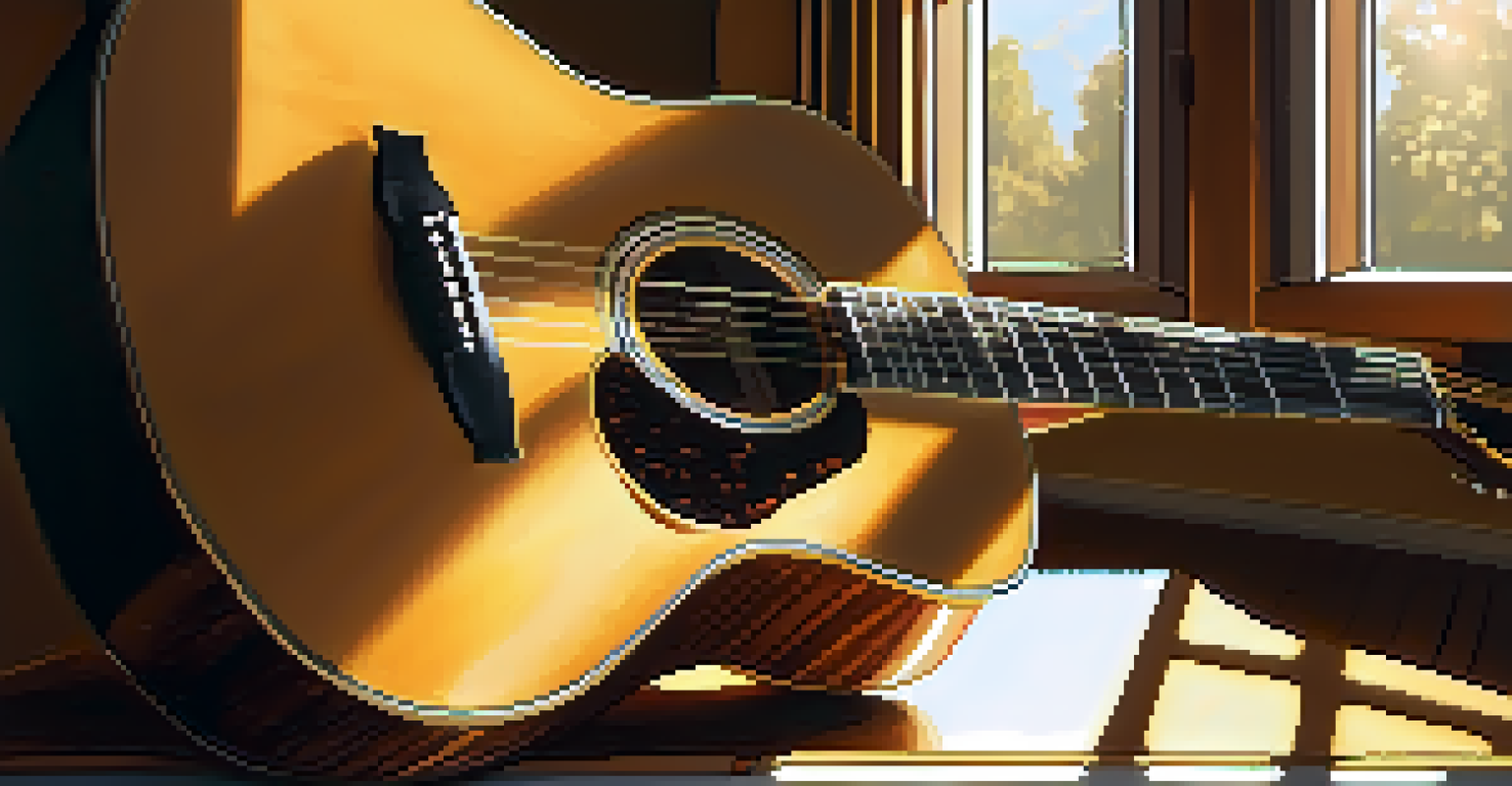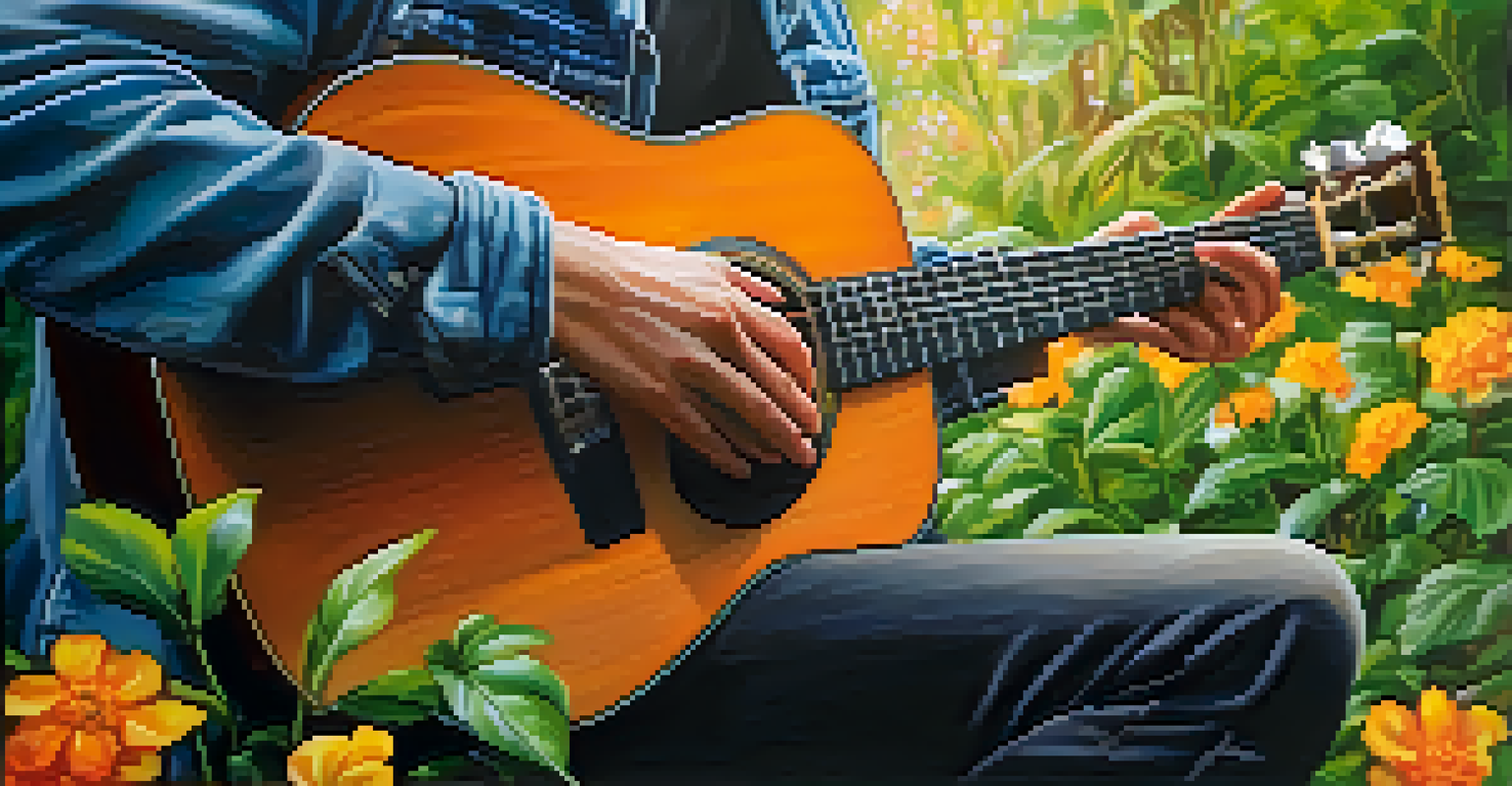Alternate Tunings in Jazz: Expanding Your Guitar Horizons

Understanding Alternate Tunings and Their Benefits
Alternate tunings are variations of standard tuning that can open new musical pathways for guitarists. By adjusting the pitch of some strings, you can create unique voicings and textures that standard tuning simply doesn’t offer. This flexibility allows for greater expression in jazz, where improvisation and creativity are key.
Music is the shorthand of emotion.
For instance, tuning the guitar to an open chord can enable you to play beautiful, resonant sounds that enhance your jazz compositions. Additionally, alternate tunings can make it easier to play certain chord progressions or melodies, providing a fresh approach to familiar songs. This can be particularly inspiring when you're looking to break out of a creative rut.
Ultimately, exploring alternate tunings can deepen your understanding of harmony and expand your musical vocabulary. It’s like adding new colors to your palette as a painter – each tuning brings its own character, inviting you to experiment and discover new musical ideas.
Popular Alternate Tunings in Jazz Guitar
Some popular alternate tunings in jazz include Drop D, Open G, and DADGAD. Drop D, for example, lowers the lowest string to D, allowing for powerful bass lines and dynamic chord shapes that can add depth to your playing. Open G tuning facilitates easy barre chords and is great for bluesy jazz riffs.

DADGAD tuning is particularly interesting as it creates a modal sound that can give your pieces an ethereal quality. This tuning is widely used in folk and world music, but it can also be a refreshing choice for jazz guitarists looking to explore different textures. Each of these tunings brings something unique to the table, encouraging you to think outside the box.
Unlock Creativity with Alternate Tunings
Exploring alternate tunings can enhance expression and inspire fresh musical ideas for guitarists.
By incorporating these popular tunings into your practice routine, you can experience firsthand how they affect your sound and style. Trying out different tunings can lead to unexpected chord progressions and melodic lines, pushing you to develop your musical voice.
Techniques for Practicing Alternate Tunings
When diving into alternate tunings, it’s essential to approach your practice intentionally. Start by familiarizing yourself with the tuning you’ve chosen, focusing on open strings and basic chords. Play scales and arpeggios within the new tuning to build muscle memory and get comfortable with the fingerings.
The beautiful thing about learning is that no one can take it away from you.
Experimentation is key. Try playing familiar songs in your new tuning to understand how the different notes interact. You might find that a simple tune sounds completely different, inspiring new interpretations and improvisational ideas. This experimentation can lead to surprising discoveries in your playing.
Another effective technique is to record yourself while practicing in alternate tunings. Listening back can provide insights into your tone and the overall feel of your playing, helping you identify areas for improvement. Plus, it’s always exciting to hear how your sound evolves as you become more adept at using these tunings.
Creating Unique Chord Voicings with Alternate Tunings
One of the most exciting aspects of alternate tunings is the opportunity to create unique chord voicings. In standard tuning, you might rely on familiar shapes, but changing the tuning can lead to new fingerings that yield interesting sounds. For example, using Open G tuning can allow you to play lush, full chords with less finger stretching.
By exploring the new relationships between strings, you can discover voicings that may not be possible in standard tuning. This can be particularly valuable in jazz, where complex harmonies are often required. Try stacking intervals in unconventional ways to create rich textures in your progressions.
Unique Chord Voicings Await
Alternate tunings allow for the discovery of unique chord voicings that enrich jazz harmonies.
Additionally, consider how these unique voicings interact with melodies. You can create beautiful counterpoints by pairing simple melodic lines with more complex chord shapes. This approach not only enriches your sound but also enhances your overall compositional skills.
Improvisation Techniques Using Alternate Tunings
Improvisation is at the heart of jazz, and alternate tunings can provide fresh avenues for creativity. As you experiment with different tunings, pay attention to how they influence your improvisational style. You might find that certain notes and scales stand out more in a specific tuning, inspiring new melodic ideas.
To enhance your improvisation, try playing along with backing tracks or jam with fellow musicians while using alternate tunings. This collaborative approach can help you develop your ear and responsiveness to changes in harmony. You may discover that your improvisational instincts become sharper as you adapt to the new tonal landscape.
Lastly, don’t shy away from playing outside your comfort zone. Embrace the challenges that come with alternate tunings, and allow yourself to make mistakes. Often, the best improvisational moments arise from unexpected notes or ideas, so be open to the surprises that come your way.
Incorporating Alternate Tunings into Composition
If you’re a composer, alternate tunings can add a new dimension to your music. By writing in a unique tuning, you can create pieces that are distinct in sound and style. This experimentation can lead to unexpected harmonic progressions and new melodic lines that you might not have discovered otherwise.
Consider setting aside time specifically to compose in an alternate tuning. As you play, jot down any ideas that resonate with you, whether they’re chord progressions or catchy riffs. This can help you develop new material that stands out from your usual repertoire, enriching your overall body of work.
Enhance Improvisation Skills
Using alternate tunings can lead to new improvisational opportunities and a deeper understanding of music.
Furthermore, sharing your compositions with fellow musicians can foster collaboration and feedback, helping you to refine your ideas. By incorporating alternate tunings into your writing, you’re not just expanding your musical toolkit; you’re also inviting others to experience the beauty of your creativity.
Final Thoughts on Exploring Alternate Tunings
In conclusion, alternate tunings offer a vast, unexplored territory for jazz guitarists eager to expand their horizons. Whether you’re looking to enhance your improvisation, create unique compositions, or simply enjoy experimenting, these tunings can be a game changer. They invite you to think differently about your instrument and your music.
As you embark on this journey, remember to be patient with yourself. Developing proficiency in alternate tunings takes time, but the rewards are well worth the effort. Enjoy the process of discovery, and allow your creativity to flourish as you explore new sounds.

Ultimately, alternate tunings can deepen your appreciation for the guitar and jazz as a whole. So grab your guitar, tune it up, and dive into the exciting world of alternate tunings – your musical journey awaits!